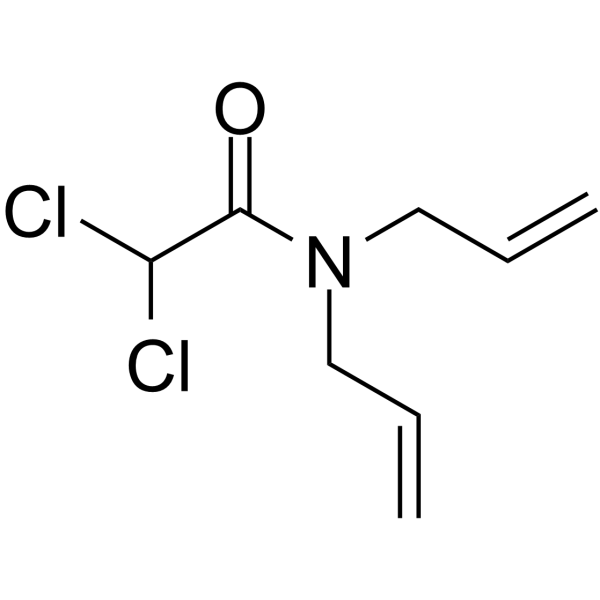
Dichlormid
CAS No. 37764-25-3
Dichlormid( —— )
Catalog No. M28302 CAS No. 37764-25-3
Dichlormid is a herbicide safener. Dichlormid up-regulates expression of ZmGST27 and ZmMRP1 and increases ZmGT1.
Purity : >98% (HPLC)
 COA
COA
 Datasheet
Datasheet
 HNMR
HNMR
 HPLC
HPLC
 MSDS
MSDS
 Handing Instructions
Handing Instructions
| Size | Price / USD | Stock | Quantity |
| 1G | 37 | Get Quote |


|
Biological Information
-
Product NameDichlormid
-
NoteResearch use only, not for human use.
-
Brief DescriptionDichlormid is a herbicide safener. Dichlormid up-regulates expression of ZmGST27 and ZmMRP1 and increases ZmGT1.
-
DescriptionDichlormid is a herbicide safener. Dichlormid up-regulates expression of ZmGST27 and ZmMRP1 and increases ZmGT1.
-
In Vitro——
-
In Vivo——
-
Synonyms——
-
PathwayOthers
-
TargetOther Targets
-
RecptorTRPA1
-
Research Area——
-
Indication——
Chemical Information
-
CAS Number37764-25-3
-
Formula Weight208.08
-
Molecular FormulaC8H11Cl2NO
-
Purity>98% (HPLC)
-
SolubilityIn Vitro:?DMSO : 100 mg/mL (480.56 mM)
-
SMILESClC(Cl)C(=O)N(CC=C)CC=C
-
Chemical Name——
Shipping & Storage Information
-
Storage(-20℃)
-
ShippingWith Ice Pack
-
Stability≥ 2 years
Reference
1.Takashi Matsumoto, et al. In Vivo Pharmacokinetic Analysis Utilizing Non-Targeted and Targeted Mass Spectrometry and In Vitro Assay against Transient Receptor Potential Channels of Maobushisaishinto and Its Constituent Asiasari Radix. Molecules. 2020 Sep 18;25(18):4283.
molnova catalog



related products
-
Lauroyl glutamic aci...
Lauroyl glutamic acid exhibits antiasthmatic effects.
-
Pentadecane-1,15-dio...
Pentadecane-1,15-diol (1,15-Pentadecanediol) is a surfactant and a lubricant that can be used in the manufacture of skin care products, coatings, and dyes.
-
Terephthalic acid
Terephthalic acid is one isomer of the three phthalic a precursor to the polyester PET used to make clothing and plastic bottles.



 Cart
Cart
 sales@molnova.com
sales@molnova.com


